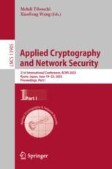Search
Search Results
-
Threshold Structure-Preserving Signatures
Structure-preserving signatures (SPS) are an important building block for privacy-preserving cryptographic primitives, such as electronic cash,...
-
Compact Structure-Preserving Signatures with Almost Tight Security
In structure-preserving cryptography, every building block shares the same bilinear groups. These groups must be generated for a specific, a priori...

-
Threshold Structure-Preserving Signatures: Strong and Adaptive Security Under Standard Assumptions
Structure-preserving signatures (SPS) have emerged as an important cryptographic building block, as their compatibility with the Groth-Sahai (GS)...
-
On Structure-Preserving Cryptography and Lattices
The Groth-Sahai proof system is a highly efficient pairing-based proof system for a specific class of group-based languages. Cryptographic primitives...
-
Improved Constructions of Anonymous Credentials from Structure-Preserving Signatures on Equivalence Classes
Anonymous attribute-based credentials (ABCs) are a powerful tool allowing users to authenticate while maintaining privacy. When instantiated from...
-
Partially Structure-Preserving Signatures: Lower Bounds, Constructions and More
In this work we first provide a framework for defining a large subset of pairing-based digital signature schemes which we call Partially...
-
Structure-Preserving Hashing for Tree-Structured Data
Many kinds of data are tree-structured, e.g., XML documents. In this paper, a structure-preserving hashing method for rooted unordered trees is...

-
Structure-Preserving Linearly Homomorphic Signature with Designated Combiner for Subspace
Linearly homomorphic signature allows signature holders to perform arbitrary linear computation on signed vectors. The special “function” makes...
-
Monotone-Policy Aggregate Signatures
The notion of aggregate signatures allows for combining signatures from different parties into a short certificate that attests that all parties...
-
Revisiting BBS Signatures
BBS signatures were implicitly proposed by Boneh, Boyen, and Shacham (CRYPTO ’04) as part of their group signature scheme, and explicitly cast as...
-
Predicate Aggregate Signatures and Applications
Motivated by applications in anonymous reputation systems and blockchain governance, we initiate the study of predicate aggregate signatures (PAS),...
-
Structure-Preserving Compilers from New Notions of Obfuscations
The dream of software obfuscation is to take programs, as they are, and then generically compile them into obfuscated versions that hide their secret...
-
Traceable Policy-Based Signatures with Delegation
In PKC 2014, a policy-based signature (PBS) scheme was proposed by Bellare and Fuchsbauer in which a signer can only sign messages conforming to some...
-
Multi-Signatures for Ad-Hoc and Privacy-Preserving Group Signing
Multi-signatures allow to combine individual signatures from different signers on the same message into a short aggregated signature. Newer schemes...
-
Formalizing Hash-then-Sign Signatures
Many practical signature schemes follow the Hash-then-Sign (HtS) paradigm: Instead of signing messages directly, messages are first hashed and then...
-
Non-interactive Blind Signatures for Random Messages
Blind signatures allow a signer to issue signatures on messages chosen by the signature recipient. The main property is that the recipient’s message...
-
Forging Tropical Signatures
A recent preprint [3] suggests the use of polynomials over a tropical algebra to construct a digital signature scheme “based on” the problem of...
-
Threshold Raccoon: Practical Threshold Signatures from Standard Lattice Assumptions
Threshold signatures improve both availability and security of digital signatures by splitting the signing key into N shares handed out to different...
-
Forward Security of Fiat-Shamir Lattice Signatures
Forward security is a desirable property for lattice-based signatures, which was posed by NIST PQC standardization against secret key exposures. The...
-
On Proving Equivalence Class Signatures Secure from Non-interactive Assumptions
Equivalence class signatures (EQS), introduced by Hanser and Slamanig (AC’14, J. Crypto’19), sign vectors of elements from a bilinear group. Their...
